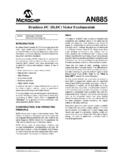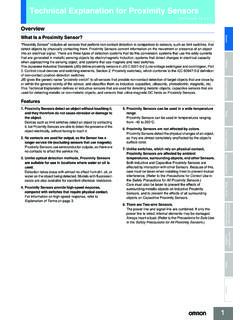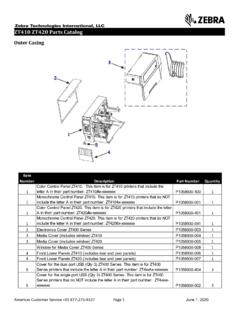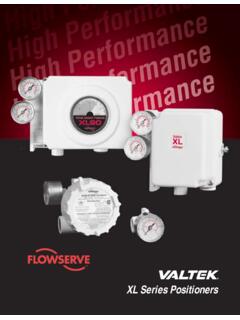Transcription of Data Logger Basics - onsetcomp.com
1 data Logger BasicsIntroductionIn today s data -driven world of satellite uplinks, wireless networks, and theInternet, it is common to hear the terms data logging and data loggers and not really have a firm grasp of what they people have a vague idea that data logging involves electronically collecting information about the status of something in the environment, such as temperature, relative humidity, or energy use. They re right, but that s just a small view of what data logging the fields of building performance and environmentalresearch, everyone seems to be using data loggers. Butwhat are they, and why are they useful?This guide will introduce you to the wide world of elec-tronic data loggers and data logging, and will help to clarify your understanding, whether you.
2 Are a new hire embarking on a project or career where data loggers are required have been asked by a supervisor or team member to purchase data loggers must persuade a decision-maker that data loggers will be useful for your work (for starters, they can save labor costs and increase efficiency by reducing travel time) have heard about data loggers and are just curious about their applications, or, are a longtime user of the devices and want to refresh your understanding and stay up-to-date with the technology and capabilities offered the following pages, we ll cover data Logger Basics (the what, where, and why); explain the steps involved in using a data Logger ; outline important considerations to keep in mind when selecting data loggers; and finish with real-world examples of data loggers being used by professionals in fields ranging from building energy efficiency to water quality management to basic scientific you ll find examples, resources, and helpful information for you to use in evaluating data loggers for your work, and you ll have a solid sense of why professionals worldwide rely on electronic data loggers more than ever as part of their Logger basicsWhat is a data Logger ?
3 A data Logger is an electronic instrument that records measurements at setintervals over a period of time. Depending on the particular data Logger , suchmeasurements can include: data loggers are typically compact, battery-powered devices equipped withan internal microprocessor, data storage, and one or more sensors. Theycan be deployed indoors, outdoors, and underwater, and can record datafor up to months at a time, unattended. A data Logger may be a single-unit,stand-alone device with internal sensors, which fits in the palm of a hand,or it may be a multi-channel data collection instrument equipped with one ormore external sensors. Why use data loggers? data loggers are valuable tools for anyone who wants to continuouslymonitor conditions without having to be on site.
4 Environmental consultants,building managers, energy auditors, research scientists, and many moreprofessionals all rely on data loggers because of their:Low costThe price of data loggers has come down with advances in microprocessorsin recent years, and a single, one- sensor Logger can cost less than $ save time and money by launching and leaving a Logger unattendedto take time-stamped measurements, rather than having to be on sitethemselves. The low cost of data loggers also allows for deployment ofmultiple loggers at a time, in some cases reducing project length andenhancing the volume of data available for of the long battery life characteristic of many portable data loggers,they can be deployed for long periods of time, meaning less time spenttraveling to and from the Logger to download data .
5 For remotely-placedloggers, or in situations where many loggers are used, that can be a hugesavings in time and money. Air temperature Relative humidity AC/DC current and voltage Differential pressure Time-of-use (lights, motors, etc.) Light intensity Water temperature Dissolved oxygen Soil moisture Rainfall Wind speed and direction Leaf wetness Pulse signals Room occupancy Plug load ..and many more2 Ease of useData loggers are certainly used by engineers and research technicians, but they re also used by elementary schoolchildren in science projects. It can be a mere 15 minutes from opening the box to deployment of a data Logger ; for some models, simply connect the Logger to a computer, use the data Logger s software to configure the sampling frequency and start/stop times, and you re ready to go.
6 Bluetooth Low Energy (BLE) enabled loggers don t even require a computer, only a mobile device and app. Downloading data is simple as well, and it can be easily analyzed, graphed, and formatted for presentation or export to other applications. We ll cover this in more detail in another configured and deployed, you can rely on a battery-powered data Logger to gather the information you need, for as long as you need. No human error, schedule conflict, inclement weather, bad handwriting, or data entry errors will affect your data collection. And whether indoors or out, data loggers are rugged instruments designed to withstand a wide range of environmental conditions, including salt water, refrigeration, strong winds, and constant dataCollection of data is, of course, at the core of these devices, and their purpose is to provide objective, time-stamped proof of conditions over time, which can be used to test theories, confirm operations, provide a record for supervisors or regulatory agencies, and supply information to decision-makers.
7 The data they collect allows for better interpretations and choices, and can save time and money in the long are data loggers used? data loggers are used in a broad range of indoor, outdoor, and underwater environments, from high-rise buildings to the Arctic essentially anywhere data is needed and the convenience of battery power is preferredOnce configured and deployed, you can rely on a battery-powered data Logger to gather the information you need, for as long as you data logging applicationsBuilding Performance Track building electricity usage to understand energy profiles and manage peak demand Verify energy cost savings to determine ROI of new equipment Monitor equipment runtimes to ensure efficient operation Monitor equipment for leaks to cut wasteful energy consumption Diagnose causes of occupant comfort complaints Ensure healthy indoor air quality Track room occupancy and light use patterns Optimize HVAC system performance Better manage peak energy demandEnvironmental Research Perform ecological studies that provide a detailed picture of the habitat Conduct agricultural research that
8 Reveals opportunities for improving yields Set up animal studies that verify the impact of climate on species Perform soil studies to understand the effects of climate on soil quality Gather essential data for more effective stormwater management Perform detailed water quality studies Conduct rigorous oceanographic research Run long-term climate change studies Study and measure environmental impact Do in-depth hydrology research that reveals the movement, distribution, and quality of water even across a broad area4 Anatomy of a data loggerLet s dig a bit deeper into what the device actually is and does. A data Logger , at its most basic, is a small device with an internal microprocessor, data storage, and one or more sensors, all housed in a hard plastic casing that is weatherproof and/or tamper resistant, depending on the most people use the term data Logger , they re usually referring to the whole device, which is comprised of a data Logger that does the logging, and sensors that measure the parameters.
9 The sensor or sensors may be housed inside the data Logger s case, or they may be attached to the Logger s sensor ports via a cable. data loggers also have either a cable port or an optical sensor , through which data can be transmitted to the user. Finally, some models have LCD screens that provide operating information, while others have simple light data loggers share these basic parts and characteristics; where they diverge is in exactly how data can be downloaded to the user. To this end, there are 3 main types of data loggers: stand-alone USB data loggers, web-based data logging systems, and Bluetooth Low Energy data USB data loggers are compact, reusable, and portable, and offer low cost and easy setup and deployment.
10 Internal- sensor models are used for monitoring at the Logger location, while external- sensor models (with flexible input channels for a range of external sensors) can be used for monitoring at some distance from the Logger . Most stand-alone loggers communicate with a computer via a USB interface. For greater convenience, a data shuttle device can be used to offload data from the Logger for transport back to a data logging systems enable remote, around-the-clock internet-based access to data via GSM cellular, Wi-Fi, or Ethernet commou knounications. These systems can be configured with a variety of external plug-in sensors and transmit collected data to a secure web server for accessing the loggers that utilize Bluetooth Low Energy (BLE)








